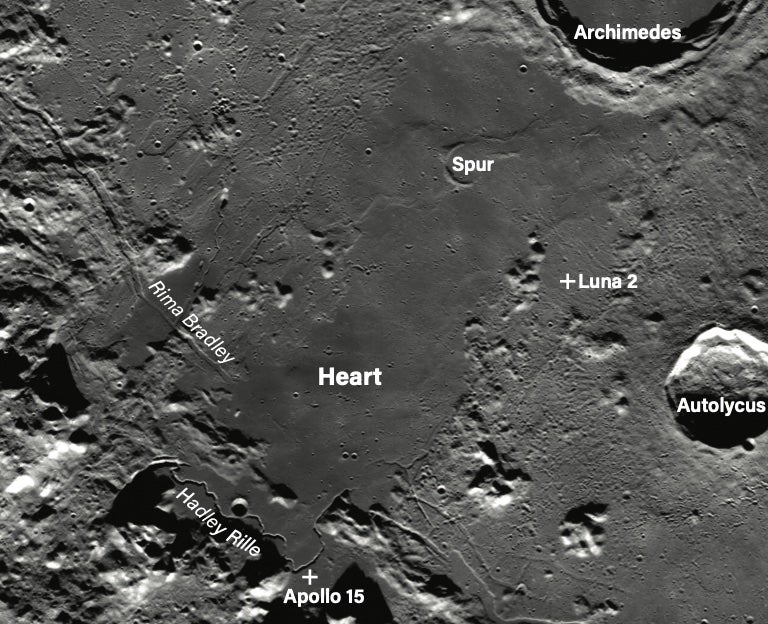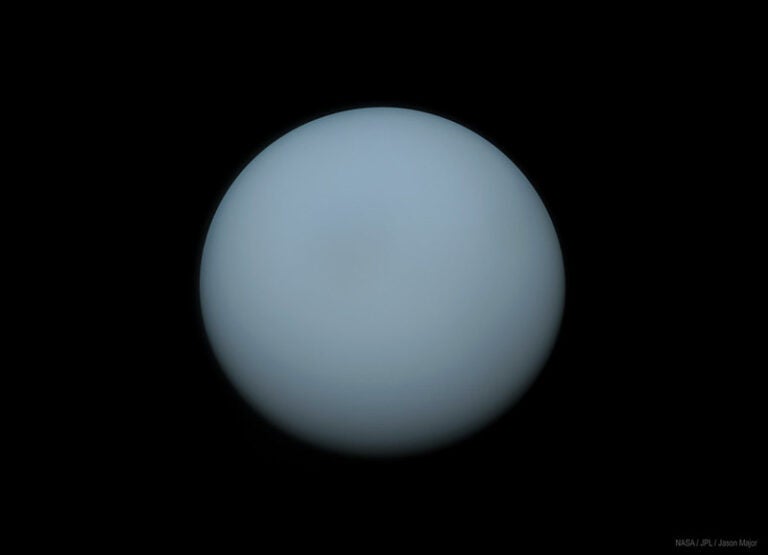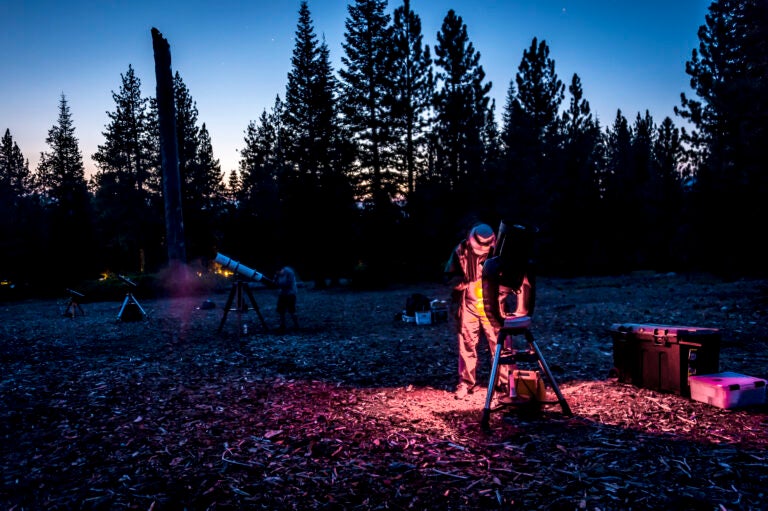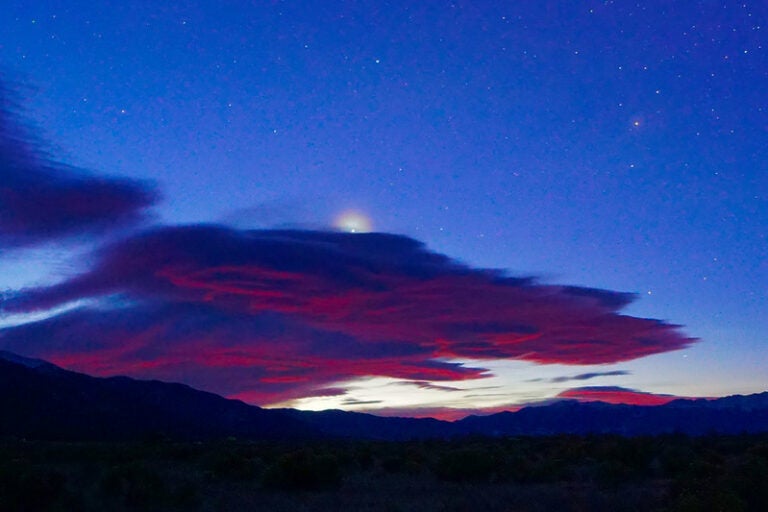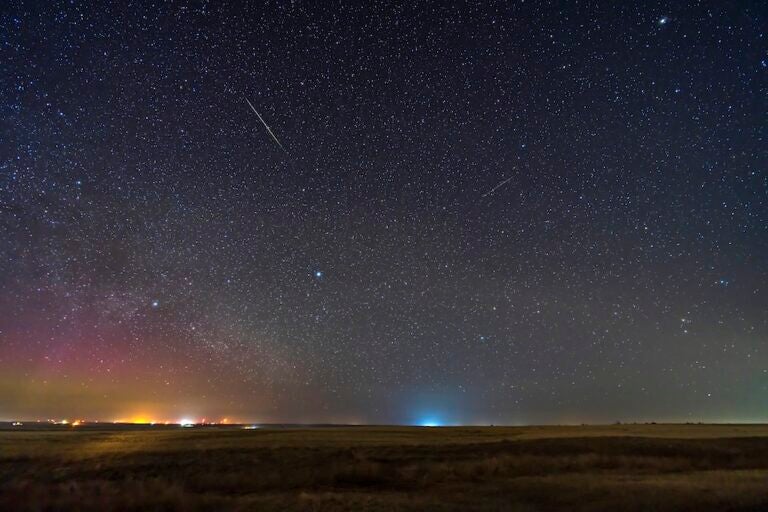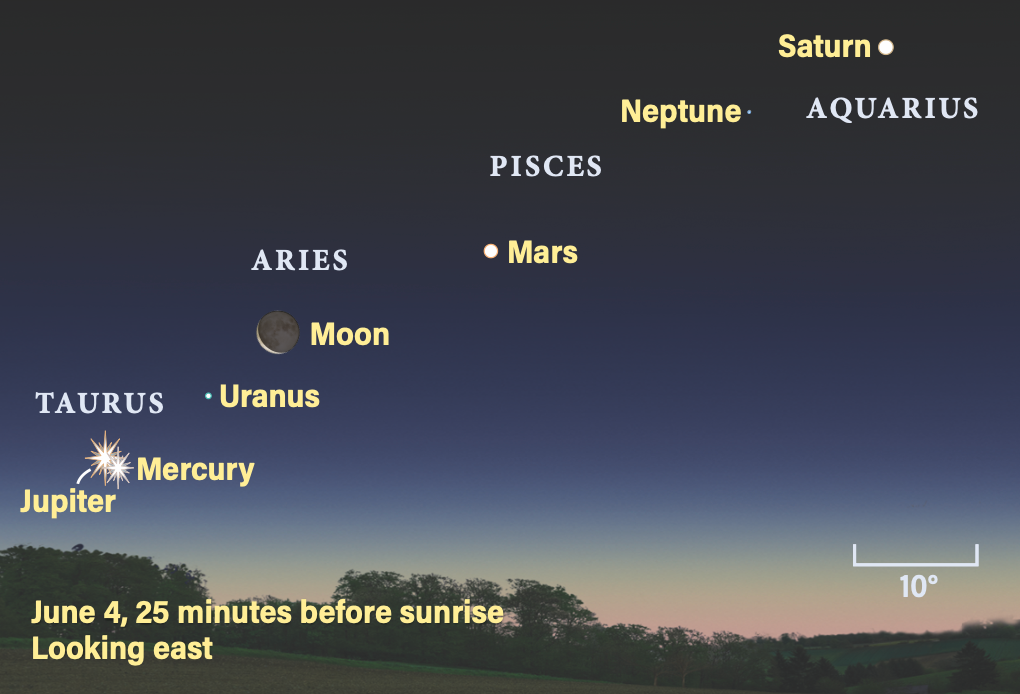
Friday, May 31
Although the Leo Trio of galaxies gets quite a lot of fame, these aren’t the only deep-sky objects to chase down within the Lion. With no Moon in the sky after sunset tonight, consider hunting down another of this constellation’s galactic gems: NGC 2903. In fact, many skywatchers wonder how Messier could have missed this gorgeous spiral, whose brightness is on par with other galaxies the Frenchman did spot in Leo.
NGC 2903 sits just below the big cat’s “chin.” To find it, first look west an hour after sunset, where Leo is slowly making its way down toward the horizon, now 50° high. You’ll easily spot the constellation’s alpha star, magnitude 1.4 Regulus, as one of the brighter suns in this region of sky.
From Regulus, see if you can find the rest of the Sickle asterism, which looks like a backwards question mark in the sky. The Sickle’s blade ends at 3rd-magnitude Epsilon (ϵ) Leonis; from this star, scan 3.3° west to land on 4th-magnitude Lambda (λ) Leo. And from there, simply drop 1.5° south to view magnitude 8.9 NGC 2903.
This spiral galaxy is roughly twice as long as it is wide, stretching about 12.6′ on its long axis. It is considered one of the finest NGC objects, and a medium-sized telescope (4 inches or so) will begin to resolve its brighter nucleus and fainter halo into distinct regions.
Sunrise: 5:34 A.M.
Sunset: 8:22 P.M.
Moonrise: 2:06 A.M.
Moonset: 1:52 P.M.
Moon Phase: Waning crescent (39%)
*Times for sunrise, sunset, moonrise, and moonset are given in local time from 40° N 90° W. The Moon’s illumination is given at 12 P.M. local time from the same location.
Saturday, June 1
June opens with a gorgeous dark evening sky that might allow you to catch a glimpse of noctilucent clouds floating high above the northern horizon. These stunning, reflective clouds are unique in that they are composed of ice crystals that condense largely on high-up dust particles left behind as meteorites streak into the atmosphere.
Noctilucent clouds form in the mesosphere, some 60 miles (100 kilometers) above the ground. Because they are so high up, they can remain in sunlight long after the Sun has gone down for those on the ground, thanks to the curvature of Earth. Thus, these clouds can appear to shine high in the sky even in the dark of night, while lower, “normal” clouds are dark blots without illumination.
There’s no special equipment needed to view noctilucent clouds, just a little luck and some patience. Step outside an hour or two after darkness falls and turn your gaze north. Note that even though they’re high in the atmosphere, these clouds may be low on your northern horizon depending on your latitude, so try to get to a viewing site where that direction is clear of both obstacles and artificial lights. Look for wispy, silvery clouds that appear lit up rather than dark or dusty. Like the aurora, noctilucent clouds can come and go, and displays may ramp up slowly — but hopefully the mild weather and moonless skies will allow for some additional stargazing even if no night-shining clouds appear!
Sunrise: 5:33 A.M.
Sunset: 8:23 P.M.
Moonrise: 2:30 A.M.
Moonset: 3:05 P.M.
Moon Phase: Waning crescent (28%)
Sunday, June 2
The Moon reaches perigee, the closest point to Earth in its orbit, at 3:16 A.M. EDT. At that time, our satellite will be 228,728 miles (368,102 km) away.
The Moon then passes 2° north of Mars at 8 P.M. EDT. Both are visible in the morning as part of the line of planets now shining in the pre-dawn sky. So, step outside early this morning about an hour before sunrise to find Mars and the Moon both in Pisces, standing 15° high at that time in the east.
The waning Moon lies west of Mars early this morning, sitting to the Red Planet’s upper right in the sky. By tomorrow morning at the same time, the Moon will be an even thinner crescent to the east of Mars, having moved to its lower left.
An hour before dawn, three planets in the six-world lineup are already visible. Mars and Saturn are both 1st magnitude, with Saturn far to Mars’ upper right (west) in Aquarius, nearly 30° high at this time. Neptune lies between them in Pisces, about 5.5° below magnitude 4.5 Lambda Piscium. The distant ice giant is magnitude 7.8 and requires binoculars or a telescope to spot.
Wait 30 more minutes, and Uranus (magnitude 5.8 — again, requiring optical aid) and Mercury (magnitude –1) have risen, with Uranus some 4.5° high and Mercury just 1.5° high. Magnitude –2 Jupiter is just rising at that time, and will need a bit longer to climb above the horizon. See if you can catch it just before sunrise, though be careful to look away and stop using binoculars or a telescope several minutes before the Sun rises from your location, which may differ from the time given below.
This lineup of planets will feature throughout the week, especially as the Moon passes through the line and Mercury and Jupiter meet in a close conjunction in just two days. Stay tuned!
Sunrise: 5:33 A.M.
Sunset: 8:24 P.M.
Moonrise: 2:54 A.M.
Moonset: 4:18 P.M.
Moon Phase: Waning crescent (18%)
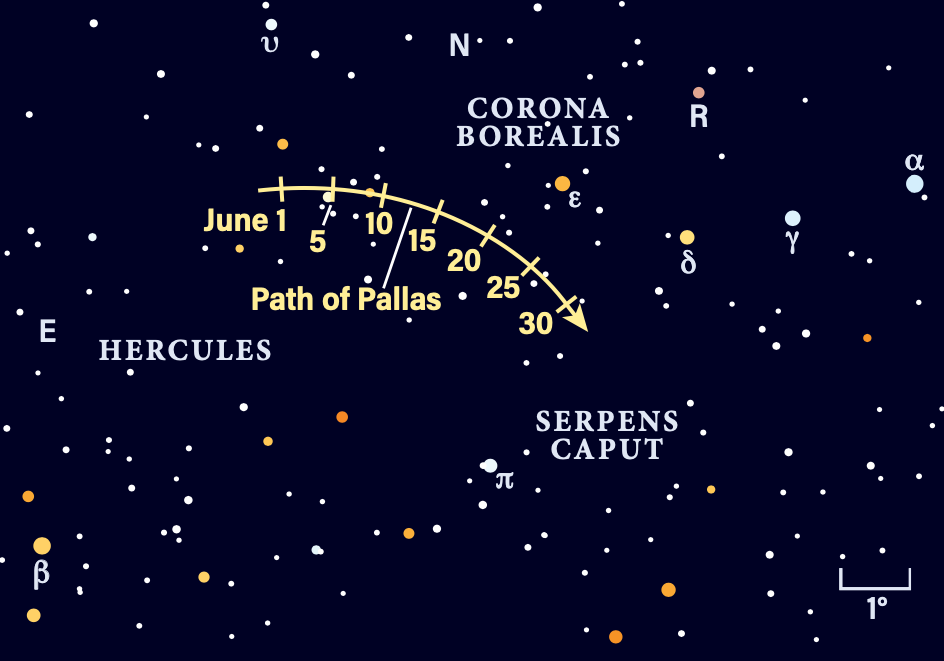
Monday, June 3
Asteroid 2 Pallas is currently moving through Corona Borealis, now within the constellation’s southeastern border. Tonight, the 9th-magnitude asteroid sits just 20′ from a magnitude 6.5 field star, but there’s actually a much easier way to find it.
Because of its location and the rotation of Earth, you can let nature do the work for you. Center your telescope on magnitude 4.1 Epsilon Coronae Borealis and simply lock it in place without tracking, so the sky appears to drift past. Within 20 minutes, Pallas will be in the center of the field!
Corona Borealis has been recently making headlines for a different star: T CrB, a star just 1° southeast of Epsilon. Normally magnitude 10 and requiring the aid of binoculars or a telescope to see, T CrB is expected to suddenly and briefly flare sometime in the next few months, reaching a naked-eye magnitude of roughly 2. Tonight, Pallas is nearly 3.5° east-northeast of T CrB; it will close in on the variable over the next few weeks and pass within ¼° of the star later this month.
Sunrise: 5:33 A.M.
Sunset: 8:24 P.M.
Moonrise: 3:21 A.M.
Moonset: 5:34 P.M.
Moon Phase: Waning crescent (10%)
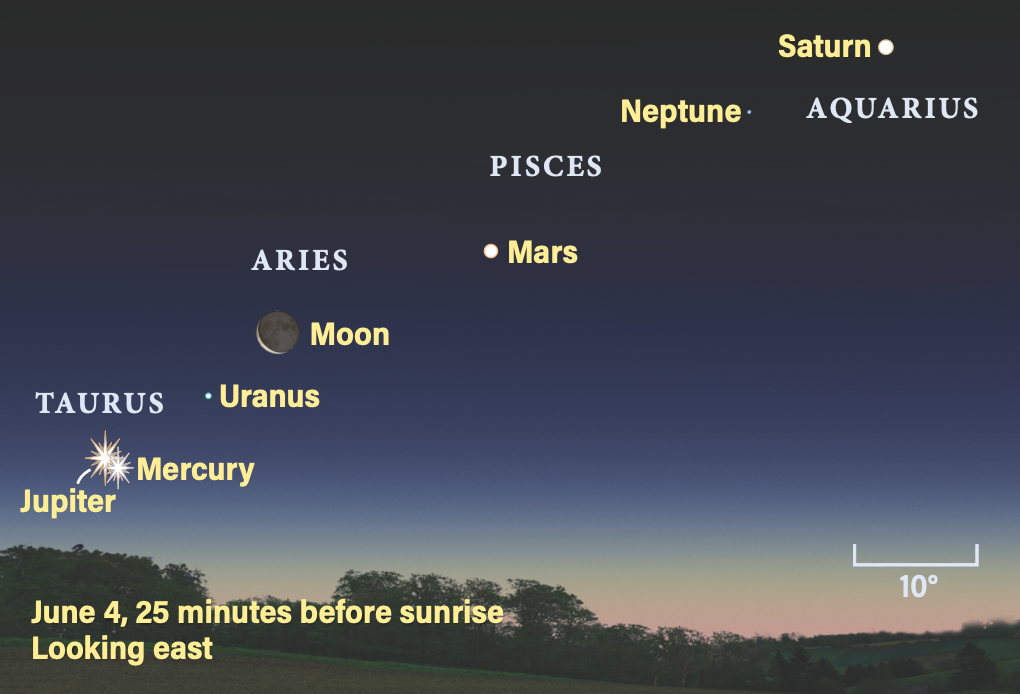
Tuesday, June 4
Let’s hop back to that parade of planets early this morning to check out a close conjunction as Mercury passes 0.1° south of Jupiter at 6 A.M. EDT.
At that time, sunrise has already reached the East Coast, while the two planets are just rising in the Midwest. Mercury lies just to the lower right of Jupiter and binoculars or a telescope will show both within the same field of view. No matter your time zone, you can catch the pair about 20 minutes before local sunrise, when they are some 2° to 3° high. It’s definitely a challenging view, but a rewarding one. Note that Mercury will continue sliding east over time, so those in time zones farther west may see Mercury directly below or even to the lower left of Jupiter in the sky.
They’re a stunning contrast — the solar system’s smallest and largest planet, together in one view! Mercury spans some 5″ and appears nearly 90 percent lit. Nearby, Jupiter is more than six times as wide at 33″ and is fully illuminated by the Sun. Its four Galilean moons are on display, though they will be hard to make out in the growing twilight. In the eastern half of the U.S., Europa is just finishing a transit across the disk, slipping off just 10 minutes before sunrise in the Midwest, so take care if you’re trying to follow the event. After that, Europa lies closest to the planet to the west, with Callisto farther west. Io lies closest to Jupiter on the east, and Ganymede sits farther east.
Moving down the line of planets, the Moon passes 4° north of Uranus at 9 P.M. EDT tonight.
And earlier in the day, Venus reaches superior conjunction at noon EDT, which is why it’s currently invisible in the bright glare of our star.
Sunrise: 5:32 A.M.
Sunset: 8:25 P.M.
Moonrise: 3:51 A.M.
Moonset: 6:50 P.M.
Moon Phase: Waning crescent (4%)
Wednesday, June 5
The Moon now passes 5° north of Jupiter at 10 A.M. EDT. The slim crescent will be a real challenge to observe, although according to longtime Astronomy contributor Stephen James O’Meara, there are some unique and beautiful effects to be seen if you can manage it.
See if you can catch the nearly New Moon in the sky shortly before dawn. If you do, you might experience the lunar blackdrop effect, which can cast dark stripes on the last illuminated bits of the lunar crescent. These stripes aren’t real, but are instead an illusion caused by both the diffraction of sunlight and the turbulence of our atmosphere, through which we are viewing the Moon (and all other celestial objects). In fact, you might notice these stripes dance, waver, or disappear and reappear if you’re able to follow the slim crescent over time. The more turbulent the atmosphere — and the poorer your local seeing — the more likely you are to see the stripes.
Particularly intrepid observers can try to catch this effect again tomorrow morning, just hours before the Moon finally reaches its New phase.
Sunrise: 5:32 A.M.
Sunset: 8:26 P.M.
Moonrise: 4:26 A.M.
Moonset: 8:05 P.M.
Moon Phase: Waning crescent (1%)
Thursday, June 6
New Moon occurs at 8:38 A.M. EDT this morning, leaving our sky dark, moonless, and perfect for deep-sky observers.
Longtime observers know that although the images of galaxies and nebulae we see are often stunningly multicolored, most objects don’t show off vivid hues through the eyepiece when visually observing. But some do, and one of these is NGC 7662, also called the Blue Snowball and the brightest planetary nebula in the constellation Andromeda.
You’ll want to catch this object in the early-morning sky, after around 3:30 A.M. local daylight time, when Andromeda has risen well above the eastern horizon. The Blue Snowball is located in the western portion of the constellation, just under 2.5° west-southwest of magnitude 4.3 Iota (ι) Andromedae. The nebula itself is magnitude 8.3 and roughly 30″ across; it’s easy to capture in most instruments. Smaller scopes will show a small, grayish smudge. But you’ll want a larger scope to pull out its deep blue color — something in the 8- to 10-inch or larger range is a good start, but bigger is better! Make sure to use high magnification as well for the best chances at a glimpse of its beautiful blue hue.
Sunrise: 5:32 A.M.
Sunset: 8:26 P.M.
Moonrise: 5:11 A.M.
Moonset: 9:15 P.M.
Moon Phase: New
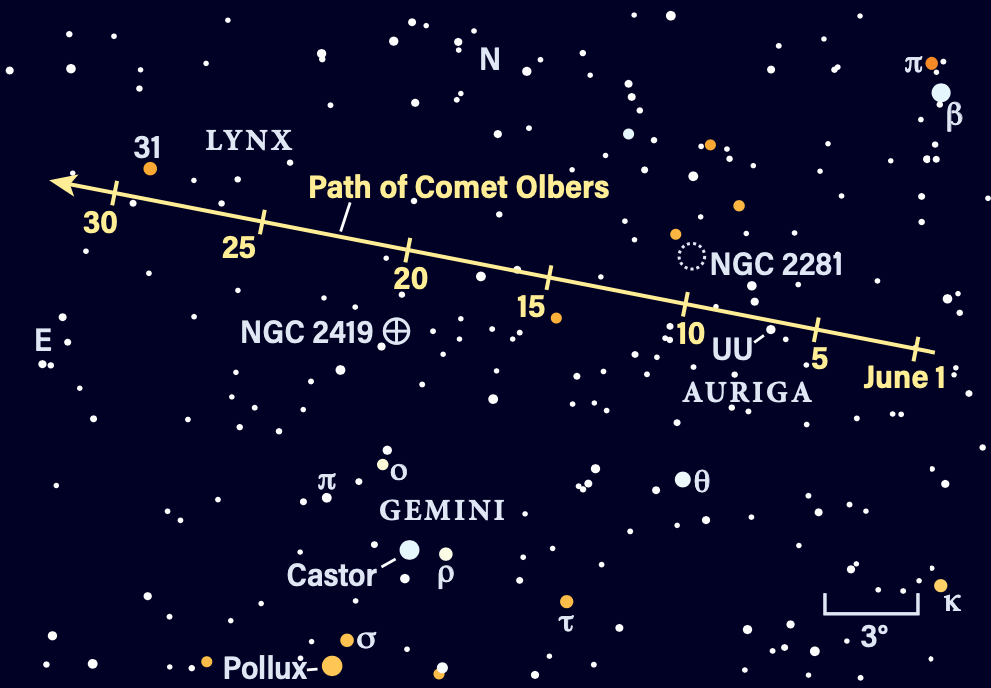
Friday, June 7
Tonight offers the first of several chances in the coming days to catch Comet 13P/Olbers near NGC 2281, a 5th-magnitude open cluster in Auriga the Charioteer.
You’ll need to be quick, though, as the constellation is setting in the west just behind the Sun. An hour to an hour and a half after sunset, you’ll want your telescope trained on eastern Auriga, just to the lower right of the bright stars Castor and Pollux in Gemini. Tonight, Olbers lies some 5.7° north-northwest of magnitude 3.6 Theta (θ) Geminorum and just 2.2° southwest of NGC 2281. The comet is currently around 8th magnitude, so a few magnitudes fainter than the open cluster but still bright enough to pick up in relatively small scopes as long as the atmosphere is clear and calm. An observing site that is slightly elevated above its surroundings and with a clear western horizon will help, too.
Discovered by William Herschel in 1788, NGC 2281 is a loose collection of young stars spanning about ¼°. Astronomers estimate the cluster is some 435 million years old. It is among many open clusters in Auriga, including the three Messier objects M36, M37, and M38. Of these, M37 is believed to be closest to NGC 2281 in age, based on the clusters’ rotational rates.
Sunrise: 5:31 A.M.
Sunset: 8:27 P.M.
Moonrise: 6:04 A.M.
Moonset: 10:15 P.M.
Moon Phase: Waxing crescent (2%)

Sky This Week is brought to you in part by Celestron.

